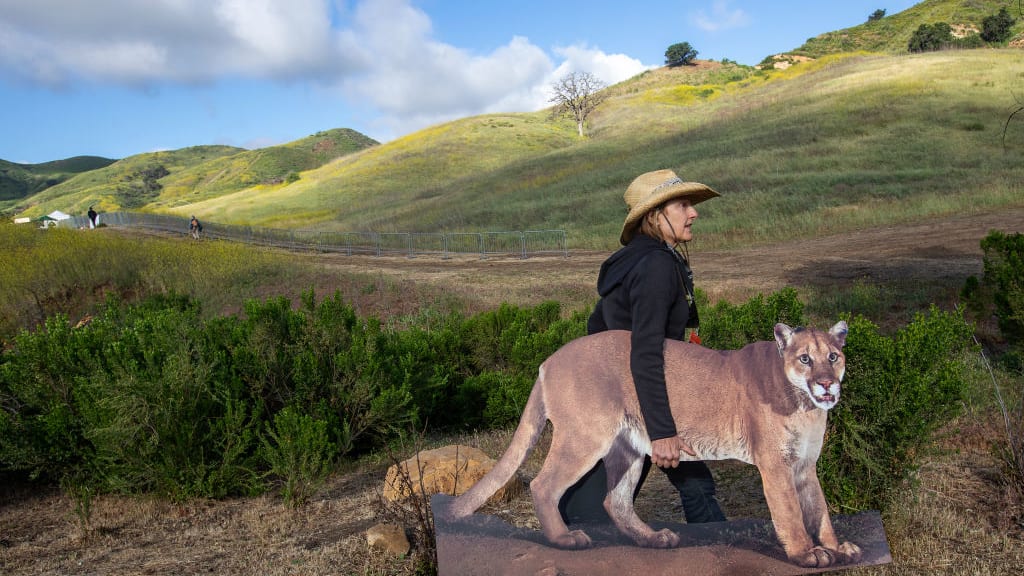The world's largest wildlife crossing is now being built in California


Spanning 10 lanes of Highway 101, the Wallis Annenberg Wildlife Crossing aims to change the fortunes of mountain lions and other animals living in the Santa Monica Mountains.
Last week, crews started breaking ground on the $87 million wildlife crossing in Agoura Hills, California, and once it's completed — the goal is by 2025 — it will be the largest such corridor in the world, CBS News reports. The 165-foot-wide crossing will connect the Santa Monica Mountains with the Simi Hills, about 10 feet above the freeway. To make sure animals use the crossing, it will be surrounded by trees, bushes, and sound barriers, so the cars and traffic below don't scare creatures away.
The National Park Service spent 20 years studying the animals in the Santa Monica Mountains, and found that urban development has genetically isolated mountain lions in the region; researchers estimate that the animals will become extinct within 50 years unless there is an influx of genetic diversity, CBS News reports. Freeways not only keep mountain lions from roaming, but are also extremely unsafe, as many mountain lions are hit by cars and killed while trying to cross them.
The Week
Escape your echo chamber. Get the facts behind the news, plus analysis from multiple perspectives.

Sign up for The Week's Free Newsletters
From our morning news briefing to a weekly Good News Newsletter, get the best of The Week delivered directly to your inbox.
From our morning news briefing to a weekly Good News Newsletter, get the best of The Week delivered directly to your inbox.
This is the first crossing of its kind in an urban area, Beth Pratt, regional executive director of the National Wildlife Federation, told CBS Los Angeles, and with its special design considerations and use of living trees and plants, the corridor is "an engineering marvel."
A free daily email with the biggest news stories of the day – and the best features from TheWeek.com
Catherine Garcia has worked as a senior writer at The Week since 2014. Her writing and reporting have appeared in Entertainment Weekly, The New York Times, Wirecutter, NBC News and "The Book of Jezebel," among others. She's a graduate of the University of Redlands and the Columbia University Graduate School of Journalism.
-
 5 prize-winning cartoons about Donald Trump's appetite for awards
5 prize-winning cartoons about Donald Trump's appetite for awardsCartoons Artists take on operatic ambitions, peace prize pacifiers, and more
-
 Will Trump’s $12 billion bailout solve the farm crisis?
Will Trump’s $12 billion bailout solve the farm crisis?Today’s Big Question Agriculture sector says it wants trade, not aid
-
 ‘City leaders must recognize its residents as part of its lifeblood’
‘City leaders must recognize its residents as part of its lifeblood’Instant Opinion Opinion, comment and editorials of the day
-
 Blue Origin launches Mars probes in NASA debut
Blue Origin launches Mars probes in NASA debutSpeed Read The New Glenn rocket is carrying small twin spacecraft toward Mars as part of NASA’s Escapade mission
-
 Dinosaurs were thriving before asteroid, study finds
Dinosaurs were thriving before asteroid, study findsSpeed Read The dinosaurs would not have gone extinct if not for the asteroid
-
 SpaceX breaks Starship losing streak in 10th test
SpaceX breaks Starship losing streak in 10th testspeed read The Starship rocket's test flight was largely successful, deploying eight dummy satellites during its hour in space
-
 A rat infestation is spelling trouble for the almond industry
A rat infestation is spelling trouble for the almond industryThe Explainer The infestation has affected at least 100,000 acres in California
-
 Rabbits with 'horns' sighted across Colorado
Rabbits with 'horns' sighted across Coloradospeed read These creatures are infected with the 'mostly harmless' Shope papilloma virus
-
 Lithium shows promise in Alzheimer's study
Lithium shows promise in Alzheimer's studySpeed Read Potential new treatments could use small amounts of the common metal
-
 Scientists discover cause of massive sea star die-off
Scientists discover cause of massive sea star die-offSpeed Read A bacteria related to cholera has been found responsible for the deaths of more than 5 billion sea stars
-
 'Thriving' ecosystem found 30,000 feet undersea
'Thriving' ecosystem found 30,000 feet underseaSpeed Read Researchers discovered communities of creatures living in frigid, pitch-black waters under high pressure
